Attack Of The Lesbian Activist Squirrels!
Please Support This Blog:
Tippers are more attractive to the opposite sex and their chainsaws always start on the first pull. The links are below. Thanks.
-
Bat Signal
-
In the event my blog goes down (regardless of reason), I'll communicate information (and possibly an alternate URL) to the following locations:
Better To Light A Fire Than Curse The Darkness: Part 3
I had succeeded! I had a smoky little fire that was just barely keeping the winter chill at bay. I had a barn cat happily purring on my lap and my dog’s grave nearby. I’d started a fire with flint and steel in darned near the worst of conditions. Good for me!
Even so, I felt alone. The sun set and I gathered another armload of firewood. It started getting chilly.
I am not a social person but humans are meant to be together. I began to miss my dog. My jacket began to freeze to the cold bench where I sat.
In general, I think cell phones are evil and addictive but I used mine to take a photo of the fire and text it to an old camping buddy. “Started fire with flint and steel. I’m as smart as and also smell like a Neanderthal!”
The signal went out the aether and the cat fell asleep. I didn’t expect to hear back. Like most men, we talk in intervals of months. I sat in the gloom not 100 yards from my house and relaxed. Slowly the fire did it’s magic and I warmed up. So did my soul. I did indeed feel better.
Then the phone rang. It was my old camping buddy. He was giddy with happiness. Certain things in his life which had been dire (and don’t belong in a blog written by me) had resolved! In fact, he was bubbly. I was aware he’d been slogging through the shit sandwich of hard times but I didn’t know it had worked out so well. I was delighted at the news.
We talked a few minutes and then he hung up. My mood had brightened considerably. His good fortune really made me happy! By now it was dark. The fire had died down and I kicked some snow over the ashes to put it out. Yes, I leave campfire ashes in my lawn. Don’t you? Why not?
The cat lounged near the heat of the fire and I said goodbye to my dead dog. I had a warm house to go to with happy people there too.
That was my Easter. How was yours?
Posted in Uncategorized
12 Comments
Better To Light A Fire Than Curse The Darkness: Part 2
To start a fire with nothing but flint and steel in these conditions might be impossible. Yeah yeah… I know. Y’all watched *Bear Grills or some fucknut on video start a fire inside a waterfall during pouring rain. Just because he did it doesn’t mean you can do it; nor I. (*Full disclosure, I’ve never seen a Bear Grylls show and I had to Google it just to find out I’d spelled his name wrong. Maybe his show is a fine and informative thing. How would I know?)
Conditions were bad. The weather has been not just miserable but almost maliciously so. The deep snowpack has partially melted (much to the relief of big game), but then a blizzard dumped a foot of wet snow on top of the half melted drifts. Then a day’s hard persistent rain turned everything into slurry. Then more snow fell on top. The ground isn’t frozen and it isn’t thawed. The forest is a basket case of mixed layers of wet dripping half-measures.
Perhaps you want to rattle off a thousand bits of tinder and material that could pave the way to success? I was having none of it. Like anyone else, I have a thousand methods of starting a fire. I left them all at the house. I intended to use as little knowledge and preparation as possible.
Having stepped out of the house, my brain instantly listed off some likely tinder locations. “This tree I remember at location X will surely have some…” Nope… I walked in the opposite direction.
As I walked, I chuckled that my “anatomically modern” brain was screaming out memorized locations of various resources. We really are meant to be predators.
It was bone chilling wet. Only about 20 degrees but windy and wet so it felt colder. Snow was lightly falling. I assumed I couldn’t do this. I’d unwisely set out not long before sunset.
I took off my gloves and started touching things. This tree bark? That thin piece of exposed cambium? Was it dry? Was it soft and fibrous? I took out a knife and poked here and prodded there. I found a little chunk of pitch. Score! Pitch won’t light easily but once it’s lit it’ll burn like uranium. I tried to brush ice off my find but that didn’t work. I got my knife all messy cutting the ice off. Now I had a dirty knife and a pea sized glob of potential energy.
Finding pencil sized twigs (and smaller) that were dry wasn’t hard. It almost never is. You just have to know where to look. For a match lit fire, I was set. I wasn’t going to use a match.
When you start a fire with a flint and steel you need very fine tinder. Much finer than branches and twigs. It’s called a “bird’s nest”. Or at least that’s what I’ve read. I’ve never had an in-person discussion of how to start a fire with iron age methods. Have you? If so, where the heck do you guys hang out and can I come? I’ll bring beer!
Anyway, I expected a “bird’s nest” to be the insurmountable challenge. Everything was soaked and thin, fine, materials are usually soaked more than other things.
I stashed my kindling and precious pitch glob back on my lawn. Then I wandered about looking for fine dry tinder. To my surprise it wasn’t too hard to find. You just have to look. Take off your gloves and run this plant or that through your hand. Some plants retain water. Some shed it. If I were a botanist I’d know the species of plant, but I don’t. All I know is that one particular species of plant was pretty dry. Well actually 99% of it was mashed to the ground in a wet mess. But 1% of the stems stood tall. On those stems were leaves. The stems were ice encrusted but the leaves were long dead and surprisingly dry. They were broad-leaved and nothing special. It’s what I’d call “grass”. Who knows the details?
So it came to this, some shit that should have been bailed in a hay field wasn’t. Most material of that sort was mashed into the snowpack, except some that wasn’t. The thick stems were of no use but the leaves were fine. I’d planned on gathering moss but I found grass. Go figure.
By now my fingers were froze. I headed back to my pile of kindling. I’d gathered a much smaller “bird’s nest” than intended. I fluffed it up in my hands, set it down, and the wind blew it away. Shit!
So I repeated the process and glanced at the sky. I was running low on time. The sun was invisible behind snow clouds but it was obviously approaching the horizon. There’s a reason I do these things as “practice” instead of “mission critical”.
I set down my second bird’s nest on a dry spot and fumbled with the flint and steel. My barn cat showed up and pushed the bird’s nest onto the ground… because what else would a cat do? I shooed it away and rescued the tinder which, fortunately, had fallen on ice (which is dry-ish) instead of a mud puddle made by my boots. Then I dropped the steel into the mud puddle.
Getting steel wet is no big deal, I wiped it off and got to work. I got a couple sparks but juggling the flint and steel and the glob of pitch wasn’t working. I think the ignition temperature of pitch is too high. I wimped out and grabbed a speck of char cloth. Char cloth is a sort of flat delicate charcoal made of linen. I plan to experiment with making some out of old denim jeans when I get around to it. It’s delicate stuff and my piece had frayed to a chunk much smaller than a dime. It didn’t work and it wound up blown to the wind. Frustrated with my modern human weakness, I grabbed a bigger piece, about the size of a small postage stamp.
Within three or for attempts I’d… cracked off a piece of my flint. Whoops.
In case you’re wondering, flint is less a geologic term for a certain kind of mineral/rock than a word that means “really hard”. To me, “flint” is “anything hard enough to bang a spark off steel”. I’m sure a geologist would disagree, but there was no geologist to consult. Just me and my pain in the ass barn cat.
This particular hunk of flint was just quartz. I scanned my predator memory and realized there were no quartz rocks within the immediate vicinity. I was in a sedimentary area. But I still had some rock left. I banged it a bit to reshape it and started again.
This time I got a spark to hit the char cloth. Char cloth is impressive stuff, it catches easily… all you need is a single tiny independent spark. No more than a speck will get it to smolder. It won’t burn with flame but when it smolders it’s hot. I wrapped it and the glob of pitch in the bird’s nest and blew. Nothing happened and then the pitch dropped out into the snow. Whoops. But I held the bird’s nest steady. I know better than to give up on lit char cloth. I shuffled the materials a bit and smelled a wisp of smoke. Uncertain where it was coming from I shifted the bird’s nest more and briefly let the snowy breeze blow air into the whole ball. That helped!
Thirty seconds later I had it smoking quite a bit. Then it burst into flame. I’d been undisciplined and hadn’t assembled the fire yet. I scrambled to add twigs, caught it just in time, and built from there.
I have a stone bench near where my dog is buried. I shifted the whole burning mess near the bench and sat down. I had a cat in my lap within seconds. I built the little fire and it was very warm. In the snow and the breeze it had a much bigger influence than it’s true size. I added more fuel and began to relax.
Wrap-up in part 3 is coming soon…
Posted in Uncategorized
2 Comments
Better To Light A Fire Than Curse The Darkness: Part 1
Where do I start today’s story? The best I can guess is last year…
Easter weekend fell seven months after a president that *unquestionably won more votes than any other candidate in history declared his “patience had run out”. (*It is literally unquestionable in that it’s socially discouraged to articulate the question and in 2022 the distance from social pressure to legal force is only a matter of power, not law.)
My continued existence was an affront to his sensibilities. I would be corrected. To that purpose he would wield the full force of the State. It was the first time an American president implied that I, an American citizen, only exist within the bounds a president is willing to “tolerate”. I see myself as a citizen, he reduced me to “subject” or “civilian” or perhaps “ward”, I took that personally.
After some faffing about I got my shit together. God told me to stand firm. I mustered the minimal courage to do that simple task. No more fence sitting, it was time to nut up or shut up. Moreover, who was I to bitch? Men have been called to die in battle, I was called to jeopardize my salary and face paperwork hassles. Hardly, the worst of fates. If that’s all to be asked of me, I’m lucky.
I’m happy there was a moment in time when it all became clear. As far as I’m concerned, if a needle forced into my vein doesn’t cross the line, there is no line. There is always a point when one more submission is too many. How many poor sinners have seen that moment in the rear view mirror? Incidentally, if you wanted the vaccine, that’s completely fine with me. Your choices are yours, mine are mine. My decision has no bearing on yours. Such self-reflection is probably how I caught the eye of Modor and why “tolerance” for me had expired.
Now it’s half a year later and I’m still standing. I’ve neither been fired nor died. The president who lacked patience with me has failed to drive me to penury and his imagined terror didn’t lead to my death. He’s moved on to other concerns; among them fomenting war. Good luck with that.
What’s next on my part? Forgiveness? Wow, talk about a challenge! To take a punch to the face is so much easier than to forgive the bully that threw the punch. Lets not try to imagine it in some candy coated way, “bullying” is what it was.
Even if I can’t forgive right now, with some recovery I can work towards that plateau. It will soon be spring and that will help. I can’t wait to see flowers and tree buds. It will come. I know it. I will see the earth renew and I will go out there and feel young and light like a yearling fawn. If a sick society fades in its deathbed, it’ll have to stay inside with the shades drawn and imaginary fears locking the door. It’ll suffer or thrive without me. I did not cause decline and I will not shoulder the burden of its self inflicted misery.
Before spring rejuvenates me I’ve got to ride out the last of winter. Winters come in all flavors. This wasn’t a mild one. The president cursed me to a “winter of severe illness and death for the unvaccinated — for themselves, their families and the hospitals they’ll soon overwhelm”. It was the mad cackling of a bully and of course virtually nothing he said happened, but I did have frozen pipes and a broken tractor.
So it came to Easter. I was and remain alive and fine… and just as Curmudgeonly as ever. “Winter of death”? Fuck ‘em!
What a conundrum! It was a Holy day and I cannot forgive. I am in error. I will someday forgive, but not yet. I want those fuckers to burn!
As is common in times of tribulation, I sought connection to nature. This is never a bad idea.
The best guess of science is that anatomically modern humans, a clunky phrase of great import, came on the scene 200,000 years ago. Theoretically, a smelly ape-like being some 200 millennia gone and I have the same brain. If we could cross the vast gulf of culture and language, we could sit by the campfire and talk about the things we have in common. The more we have in common, the better life I’d be living right now. We could talk about fishing. We could talk about hunting. We could talk about fire. If I met a caveman and we could get along enough to find a rapport, we’d both laugh if one of us ripped a fart. I don’t care who you are, farts are funny.
I would love to have a discussion with primitive man. It would be cathartic. My troubles would seem stupid and self inflicted to him. If I tried to piss and moan about taxes and politics it would seem retarded and unaware; the conversation would always veer back to our interactions with the lovely planet we both inhabit. Also, can you imagine the ecological knowledge he’d have at hand? He’d know more about a late spring or rabbit hunting than I’ll ever know. And what deeper knowledge of the universe would he have to share? I can barely taste the hint of the infinite, but he’d have lived it. A man who has slept under the stars knows something one who’s slept in a house doesn’t.
I grabbed a steel and some flint, stuffed it in my pocket, and went for a walk. Flint and steel puts me in the Iron Age; around 1,200 BC or so. Sorry, paleolithic man, I’m a bit tired today. I can’t go back that far. Maybe we’ll have a conversation in August, after a dry spell. Right now my brain is too weak and modern, also the forest is wet.
Stay tuned for part 2…
Posted in Uncategorized
Leave a comment
Camping Gear Discussion: Photos & Testing
(This is a continuation of my earlier post. Note: I’ve included links to Amazon. If you use the links and subsequently buy shit from Amazon… no matter what it is… I get a tiny kickback. I will use it to buy whiskey and fishing lures! The kickback costs you nothing. Amazon requires me to inform you of this. I suppose they want to protect the last living being on earth who has no idea how affiliate links work. Also, if you think I’ve got a nefarious plan to manipulate my millions and millions of deeply devoted and incredibly rich readers so that I can amass funds to buy a yacht a nickel at a time, this is the proof.)
I’ve got cabin fever. I couldn’t wait for proper weather so I did a test in shitty weather, which I suppose is a much better test. In mid-test the shitty weather got immeasurably worse; because of course it did. At least I got a good cup of coffee out of it.
The first photo is the first firing of my Coleman 533 Dual Fuel stove. I don’t know how many of these are still out there but if you’re interested in getting your own, don’t dawdle!
You know it’s brand new because there’s no soot on the top. It’s scandalously clean. In this photo it isn’t even heated up yet, that’s why the flame is yellow.
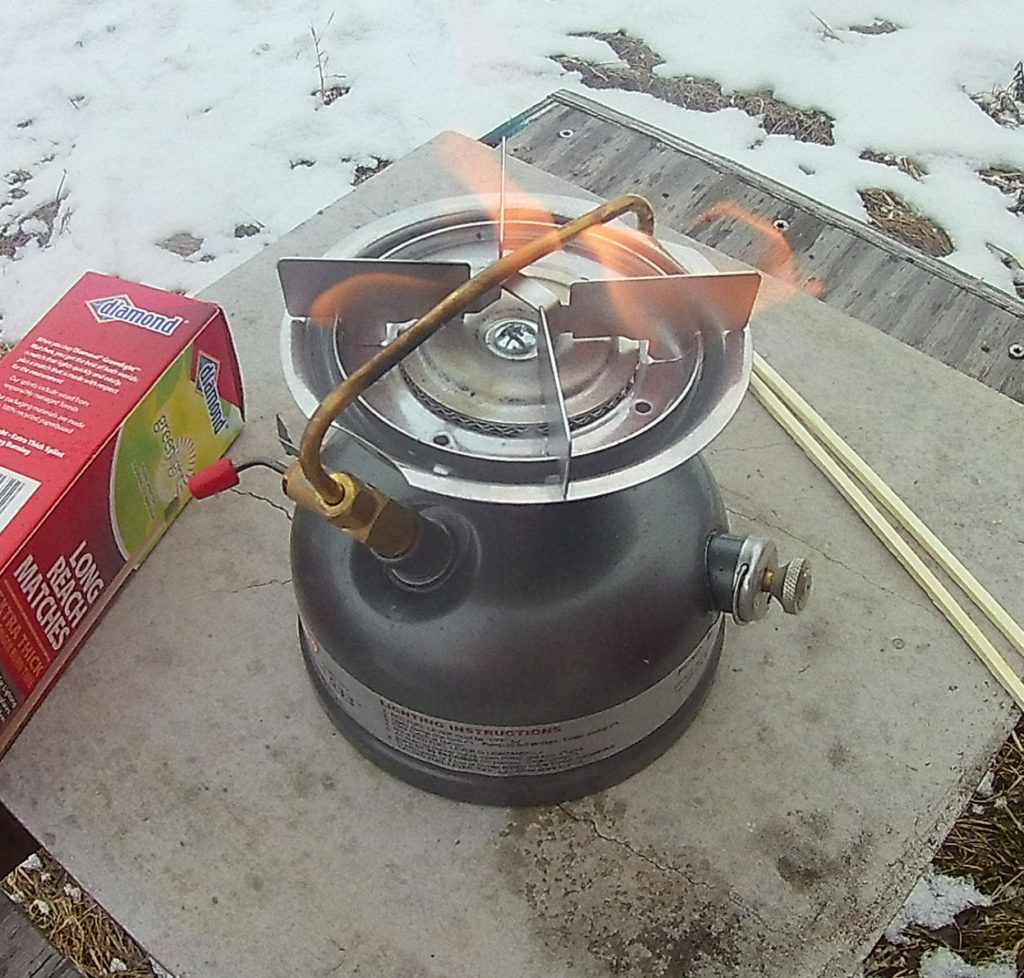
A word about fuel:
For fuel I was burning “Crown brand” white gas from Walmart. I didn’t treat this fuel particular well. I got it last year for a failed test of my two old white gas devices. That means I broke the seal and used some of the can. Then left the rest of the can in a freezing garage over the winter. It seems OK.
Don’t get screwed when buying fuel. Coleman sells its brand of white gas for $11.99 a quart. That doesn’t sound too bad until you do the math and come up with a heart attack inducing $48 a gallon! Holy crap!
Walmart sells Crown brand white gas for $7.64 a gallon (or at least that’s what their web page says, I can’t remember what I paid last year). I can’t imagine there’s any difference between the two brands.
Camp stoves don’t need a lot of fuel but it adds up. Compare $48 for a gallon of Coleman brand, $7.64 for a gallon of Crown brand, versus $5 a gallon for unleaded (which the dual fuel stove can digest). Those are big differences!
(Let pause now to reflect on fuel prices and our super smart and very active president who undeniably, unquestionably, without the slightest doubt, won the highest number of votes ever recorded in America. Gasoline prices doubling during his first 15 months in office is unquestionably someone else’s fault and that’s why he’s just so darned popular.)
The stove’s packaging says that 1 gallon of white gas is the equivalent of 4.5 pounds of propane. That seems to agree with what I’ve read on-line. I’m a little sketchy on the current cost of a one pound disposable propane tanks or most anything else that I can’t personally verify. A while ago I stocked up on disposable 1 pound tanks for $4 a pop but that was before the unassailable, squeaky clean, election that had the highest vote count ever tallied. For reasons utterly unrelated to that event, I don’t think anyone will be buying propane canisters for $4 in the foreseeable future. Right now Amazon is selling camping propane at $10 each. I can’t believe $10 is the normal cost?!? That’s nuts right? For the sake of discussion, I’m going to assume $6 per one-pound tank is the reasonable price nowadays? That means $27 worth of disposable propane tanks (adjusting for one that will be only half consumed and paying $6 each) to equal $5 in unleaded or $8 of white gas bought at Walmart.
I haven’t tested with unleaded yet. It is said that white gas burns cleaner than the EPA mandated witches brew they sell at an unleaded pump. I don’t doubt it. Some folks get all whiny that using unleaded will clog up the stove and do all sorts of mayhem. This seems more “perceived wisdom” than people who’ve tried it. Others say they’ve personally used unleaded for many years and report it’s fine. Once I get the ball rolling, I intend to use unleaded exclusively. If it’s a bad idea I’ll let you know. (I’ll be prepared for more frequent cleanings.) By my math, even if unleaded nukes a generator after a few years, the replacement generator will cost vastly less than the consumption of more expensive fuel.
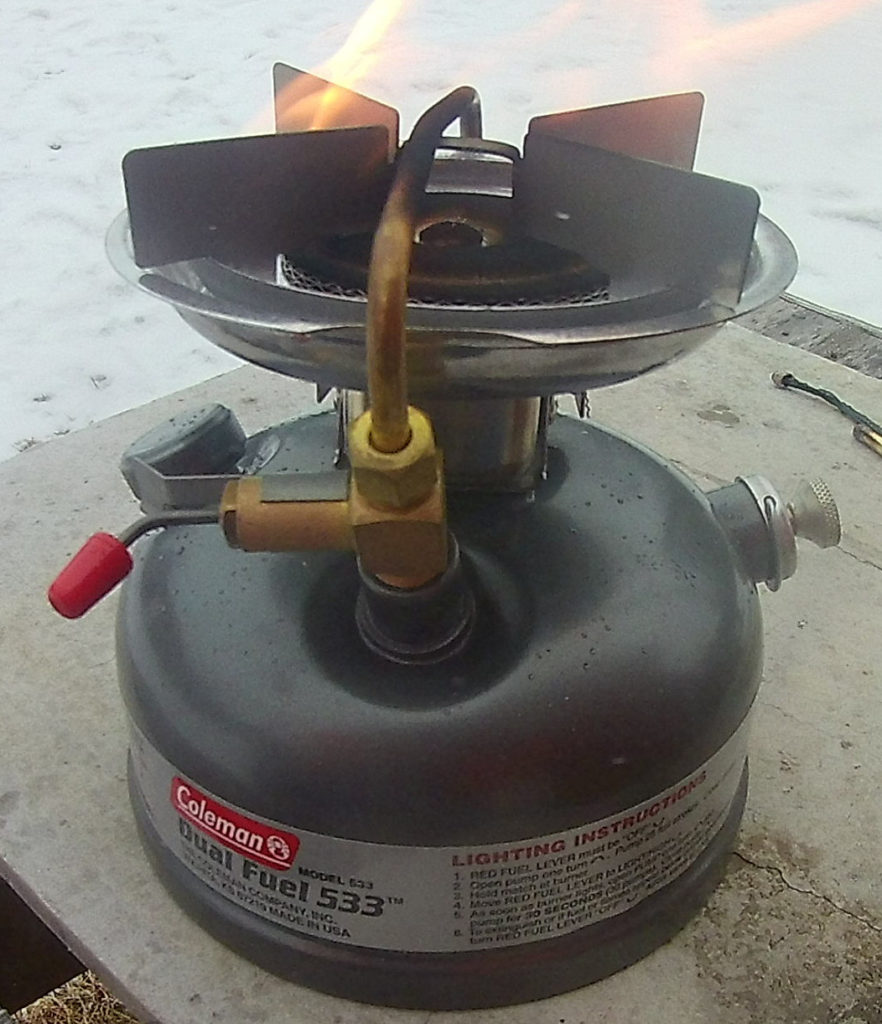
You can see the difference between the above photo which is not too far from operating temp and brand new below. BTW: The soot on the burner is not a problem It’s supposed to get discolored.
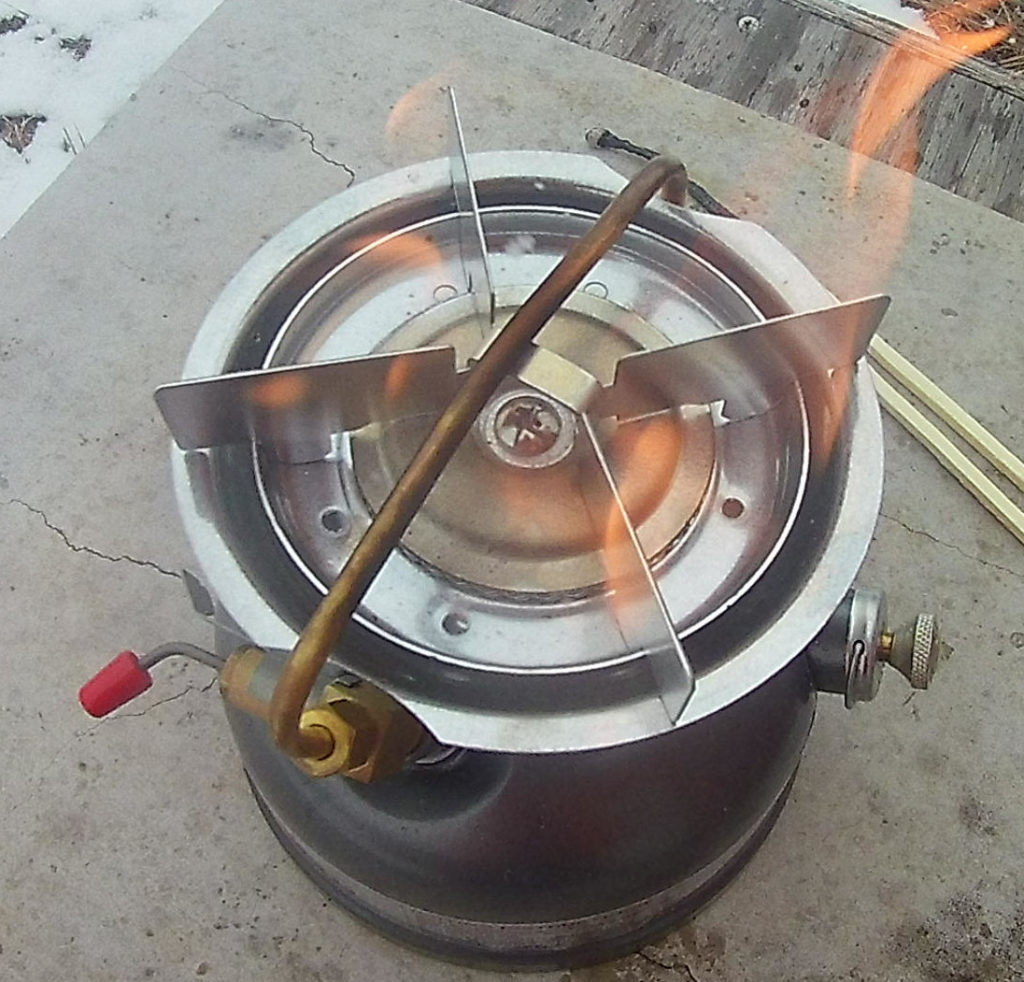
A propane burner’s flame is nice and blue within seconds. A liquid fuel burner takes a minute or two to warm up. The snow started blowing and that didn’t make me feel very patient. (You can see snow melting on the tank.)
Now for the test. COFFEE!
A word about percolators:
This test involved a new Stanley Percolator. Mrs. Curmudgeon heard me whining about my other camp percolator and got me this one for Christmas. She’s a keeper!
There’s a reason why I’m particular about percolators… actually there’s two. The first is that I take coffee seriously. The second is that my previous percolator was more optimized for an open fire than a stove. It is big and clunky and sooty. Also too much of a hassle for inside my hot tent. (I’ve already tested the new percolator on a wood stove inside a tent.)
On a stove there’s no smoke to mess up the shiny percolator. I’ve also tested it on a propane burner and there was no soot from that either. (Much like a house with a kitchen LP stove doesn’t soot up a frying pan.)

I have had other percolators. A pretty blue one Mrs. Curmudgeon got me sprung a leak after a few year’s use. That’s weird, but it happened. Shame because it was cool. Here’s the old blue on a generic propane burner. Pretty, but on the propane stove it was tall and wobbly!
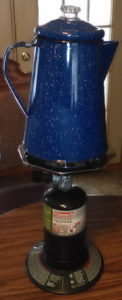
Later I bought a stainless steel percolator. I’ve used the hell out of it. Here it is when brand new (also perched on a propane burner):
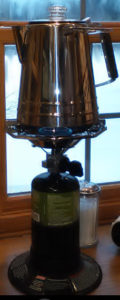
Here’s a photo of that same percolator on a campout last year. I wash the shit out of that percolator after every trip but as you can see, it gets pretty sooted up when I’m burning wood (in this case pallet wood). The big wide bottom is ideal for a fire or my folding outdoor woodstove. (Also, the lid is a little warped but it has been used hard so I can’t complain.)
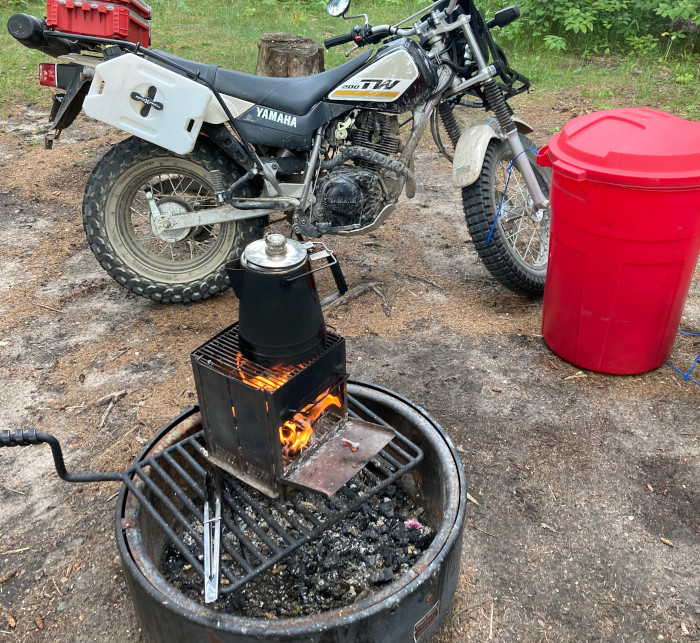
The new percolator is totally unblemished but it is camping gear. It must be tested as it will be used. It was born soot free but it will not stay that way!
Here’s an important note. The Stanley percolator fits on a propane campstove but not well… it’s a little too narrow and it feels sketchy. I checked the Stanley’s fit on an MSR burner and it was the same; adequate but not great. (In case you’re wondering, I walked into a sporting goods store carrying a percolator and put it on the display model MSR to see the fit.)
To my delight the Stanley percolator fits more or less perfectly on the Coleman stove!
Here’s the virgin percolator and the brand new stove:
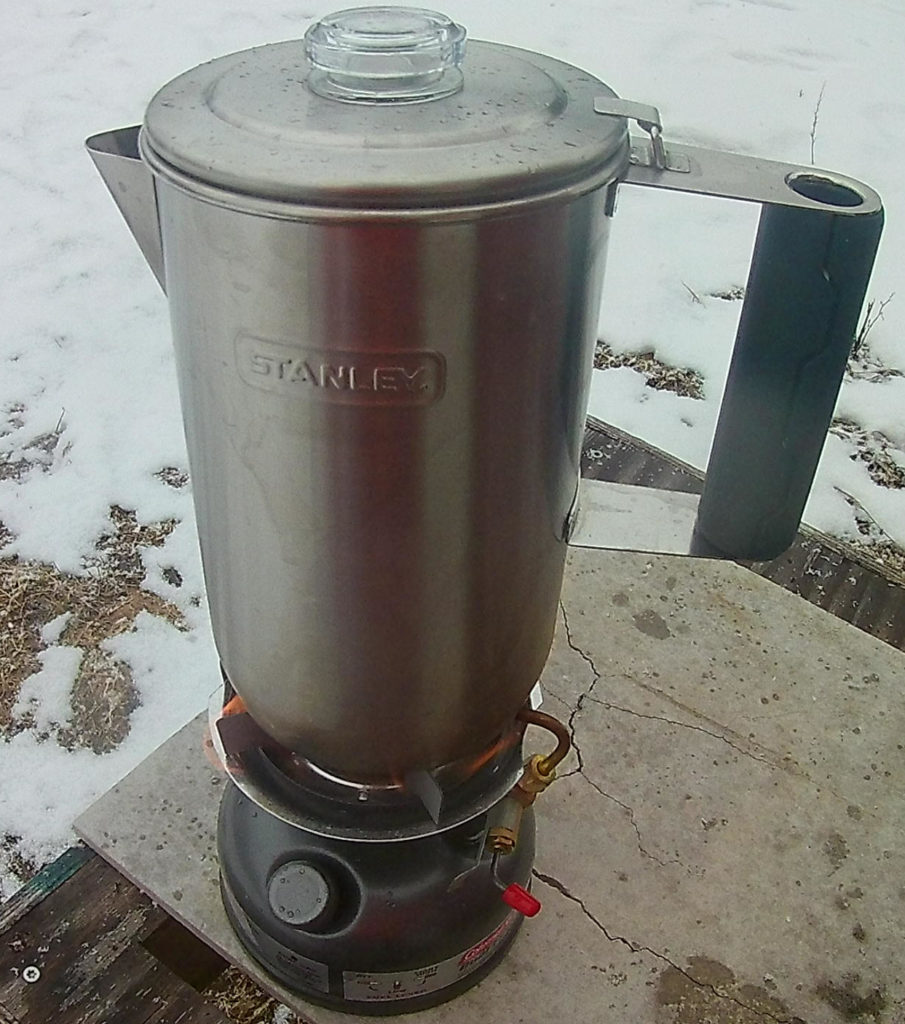
When camp cooking, I rub bar soap on the bottom of anything that’s going to get sooty. I do this before I cook. That way cleanup is much easier. I didn’t know if that was necessary over white gas so I didn’t do it. That was probably the correct call. There’s more soot than from propane but vastly less compared to wood. BTW: I’ve sent the percolator through the dishwasher a half dozen times already. It works great. It’s a tool not a display piece.
There’s a silicone handle cover that’s removable. The instructions say to remove the silicone piece if handle is exposed to flame. On the propane burner I think I’ve left it on but I can’t remember. On the tent’s wood stove I left it on because there was heat but no flame. On the Coleman 533 I removed it because the flames occasionally went up and around the percolator’s base.
I’m not sure how tough that handle is but I don’t want to damage it. Also, I’m extra careful that I don’t lose the handle. I’m sure Stanley would rake me over the coals for a replacement if it was even possible to source one. Here’s a picture with the silicone piece removed. I can almost smell the coffee!
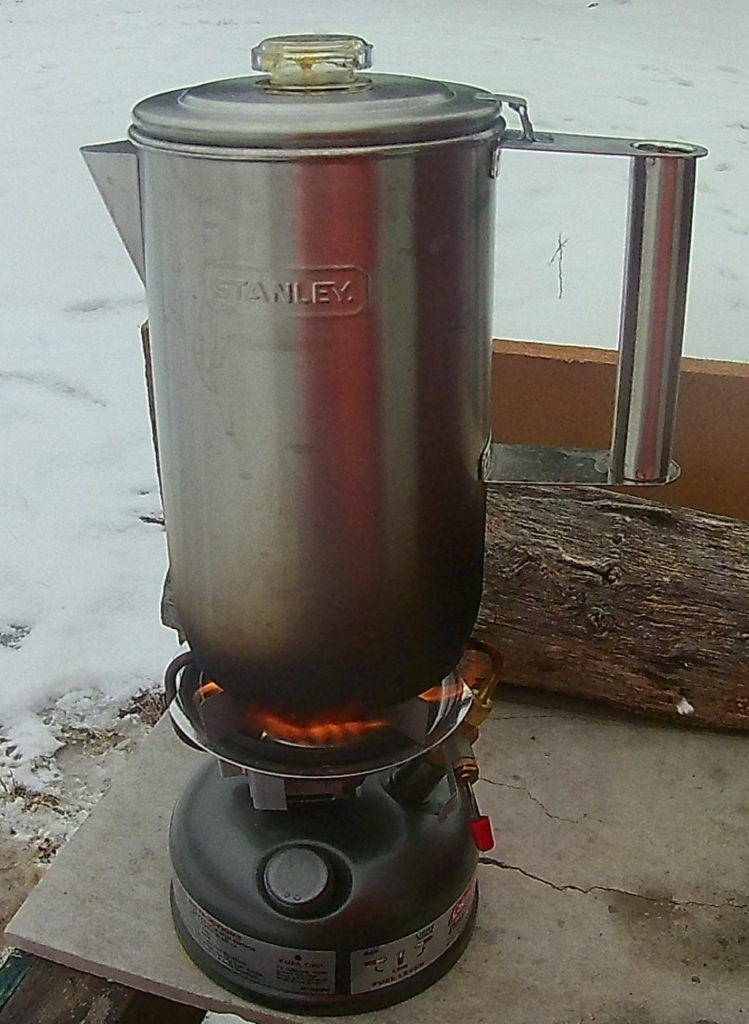
It came together perfectly. The percolator is now “broken in”.
I tried to block the wind but it was a pretty lame attempt that wasn’t very successful. I guess I’ve proven that I can percolate coffee in 20 degree weather with wind blowing the flame all over the place and snow landing on everything. I don’t know how much that affects cook time but it can’t help. It wasn’t as fast as I’ve gotten used to from summertime use.
Incidentally, the coffee was excellent. I mean just plain incredible!
Successful test, but immediately after the coffee was ready it was over. I was driven back indoors by the elements. We now have an additional 3″ of snow on the ground.
Posted in Uncategorized
4 Comments
Camping Gear Discussion: Restoring Old Friends And Buying Their New Counterparts
I haven’t been camping much lately (because the weather is a total mess!) but I’m still optimistic about the summer. Here goes with my newest plans…
Changing Lanterns:
Last October I pondered changing some camping gear. I mentioned it as an aside in Skunked By Grouse: Motorcycle Trip: Part 2: Campsite Mechanic. Here’s what I said:
“I use a little LED area light for camping and it does the job well, but I started thinking about my antique Coleman lantern. If I’m going to get into a groove (rut?) of State Park camping, maybe a brighter light emanating from a delicate device is appropriate? Electronics are super handy and lantern mantles break. But an antique would fit my attitude, not a small concession.”
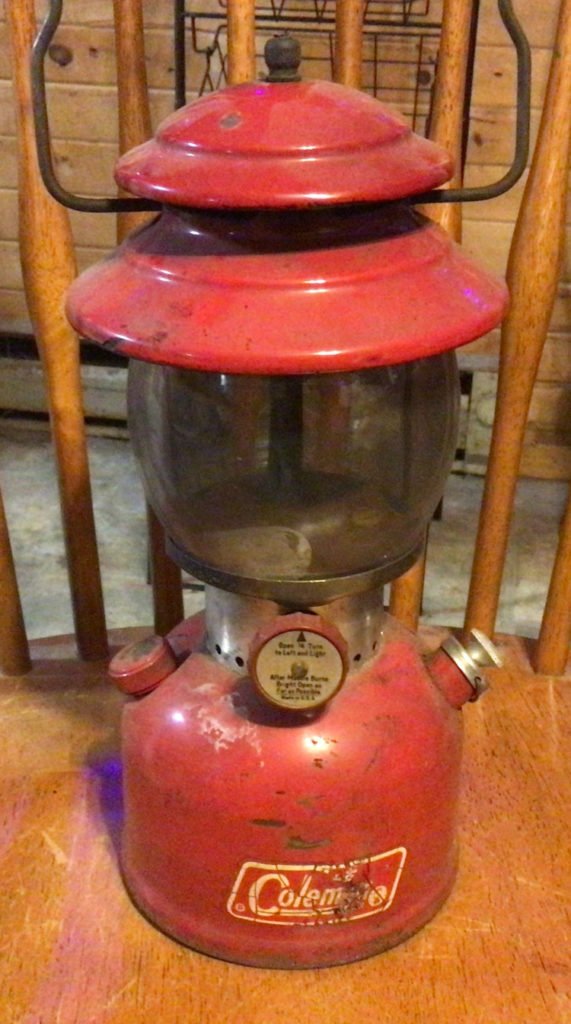
Pictured is my old Coleman single mantle lantern. It’s over 50 years old. I’m not sure where I acquired it. I think I bought it at a garage sale in Maine three decades ago but who knows?
Sadly, but not unexpectedly, it doesn’t work. This is through no fault of the lantern. I’d neglected it during several decades of prowling deeper and more inaccessible realms of nature. When you’re a zillion miles from nowhere and carried everything there on your back, heavy delicate lanterns aren’t reasonable; you reduce weight or die trying.
Now I’m reverting to earlier and more mellow ways. I’m shifting into car camping (or Dodge camping). I can now afford the weight and hassle of a lantern. If I use it I’ll be getting back in touch with an old friend.
I watched a zillion YouTube tutorials and tore the lantern to pieces (carefully). Then I ordered most of the necessary parts. While waiting for parts delivery, winter hit hard and my shop froze. I postponed the effort. Some things scream for a well ventilated, non-flammable environment that’s not the house. I don’t need the drama of fixing it at the kitchen table.
The lantern has been sitting in pieces in a cardboard box. I will get it done (glances out the window and sees it’s still snowing) but not yet.
Changing Stoves:
I also dug out my old single burner Coleman stove. It’s a Coleman Peak 1 and this bad boy is a trusted friend and companion. (Note: The photo is a random pic from the internet but they all look the same.)
I don’t know how old mine is, I’d guess it’s maybe 38 years old. (Mine is a little dirtier than this one.)
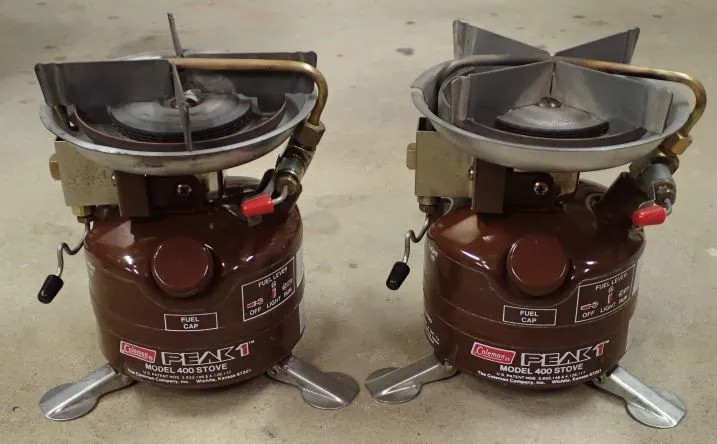
I carried the plucky critter many places and used it very hard. Alas, I neglected it too. A few decades of ultralight camping and the siren song of a JetBoil powered by butane set the plucky device back a bit. I probably last used in around 2005 or so. Unsurprisingly, it’s not working. I didn’t tear it apart because I didn’t want to mix lantern parts with stove parts.
I am 100% confident I can buy parts and fix this stove too. I will. But not yet.
Thinking About The End Of The World:
So that was the plan. I’d fix up a 50 year old lantern and a 38(?) year old stove. That would make a nice two piece ensemble for “car camping”. However, I got to thinking. If the world insists on crawling up it’s own ass, shouldn’t I do more to “prepare”?
In case you haven’t noticed, the whole world has gone to shit since 2019. Regardless of your politics, you see it. Rule of law, supply chains, society itself… it’s all seriously less stable than it was in 2019. It’s dumb to pretend it’s not happening. Waiting for a return to “normal” is a form of denial.
Both the lantern and the stove can be infinitely repaired and parts are available, but they run on white gas. Right now, white gas is readily available. It has been so all my life. It will remain readily available; right until it’s gone or rare.
Back when I used the Peak 1 more or less constantly, there was similar alternative stove that ran on white gas OR unleaded. (That was so long ago they called the stuff you put in some cars “unleaded” and it was to differentiate from “leaded” fuel you put in other cars.)
I did some research and the “dual fuel” devices are still common, liked, and readily available. NOT!
I can find endless videos and reviews of Coleman dual fuel devices but they’re mostly several years old. Coleman itself doesn’t specifically say they’ve stopped making them. Stores don’t specifically say they don’t exist. There’s no announcement by anyone that dual fuel / liquid fueled devices of this sort are “discontinued”… but good luck finding one in real life. Like sanity, they’re not officially “gone” but you can’t find them.
You’re probably laughing at me. You probably think you saw one last week at WalMart. Fine! Whatever. All I’m saying is that I looked and it was a wild goose chase.
My theory is that some lawyer somewhere decided unwashed dipshit deplorables in fly over country shouldn’t be pouring unleaded into camping gear. Not banned in writing but de facto banned in practice. (Admittedly, it’s easier to set your ass on fire with liquid fueled stoves and lanterns than gas powered ones.) My alternate theory is that the profit margin on disposable 1 pound propane bottles is too dang tasty to undercut it with liquid fuel devices?
Don’t believe me? Look around for yourself. You’ll find white gas at any WalMart but everything made by Coleman that’s stocked on the shelf runs on propane. I have nothing against propane. It is convenient and (mostly) idiot proof. In fact, I’ve got several propane burners. But that’s not what I wanted. (Nor am I interested in a two burner “suitcase style” stove which seems strangely more commonly found.) Aside from casual use and my Mr. Heater Buddy I have a desire for non-propane devices.
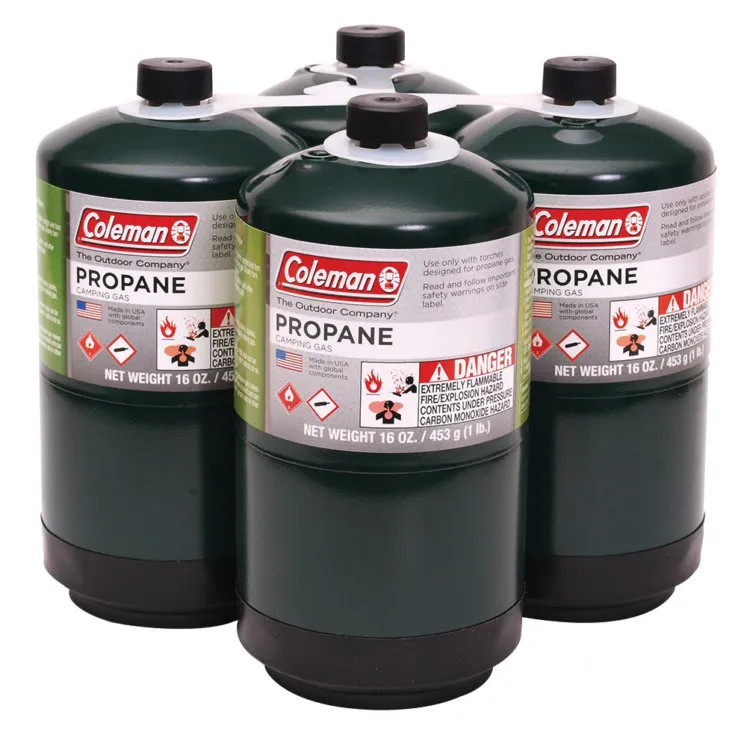
It became a quest. I wanted to power lighting and cooking off gasoline. I got pretty pissed off about it.
Why? Because I like gasoline!
New Toys:
It’s bullshit that a simple mature technology that had been sitting on shelves my whole life was suddenly gone. Taken away for no reason at all. The McRib of the camping world!
I looked long and hard. I searched in five states and finally found two dual fuel lanterns on a dusty forgotten shelf at the back of a Bass Pro Shop. I bought one. I considered buying both to “flip” one on e-bay but I left it in case there’s a kindred soul out there. I hope it’s found by someone like me who’ll enjoy it.
As far as I know, that’s the last time I’ll see one in a store.
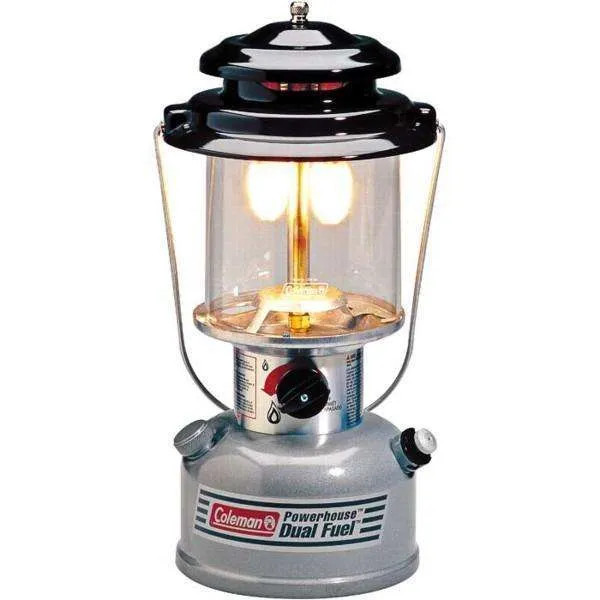
It was even harder to find the stove. (I wanted one burner, not two burners.) It feels like they just aren’t made anymore. If they are, I couldn’t find one in person.
Ominously, there’s a very active market in “refurbished” and “useable” and “antique” variants of this device. A five year old used but good working one burner dual fuel Coleman stove can be sold right now for more than you paid to buy it. (In case you’re wondering, that’s a sign that both society and the economy are in decline.)
I gave up looking in person. I ordered a brand new stove from a third party supplier that was not Coleman. I assume it’s the last of some dwindling supply on a pallet in a warehouse somewhere. The seller I bought from said they had 4(!) left. I don’t know if that’s true. Maybe they’ve got a container ship full of them. YMMV.
It wasn’t cheap, but since they only recently became (“temporarily unavailable”) the premium wasn’t too bad. It was worth it to me.
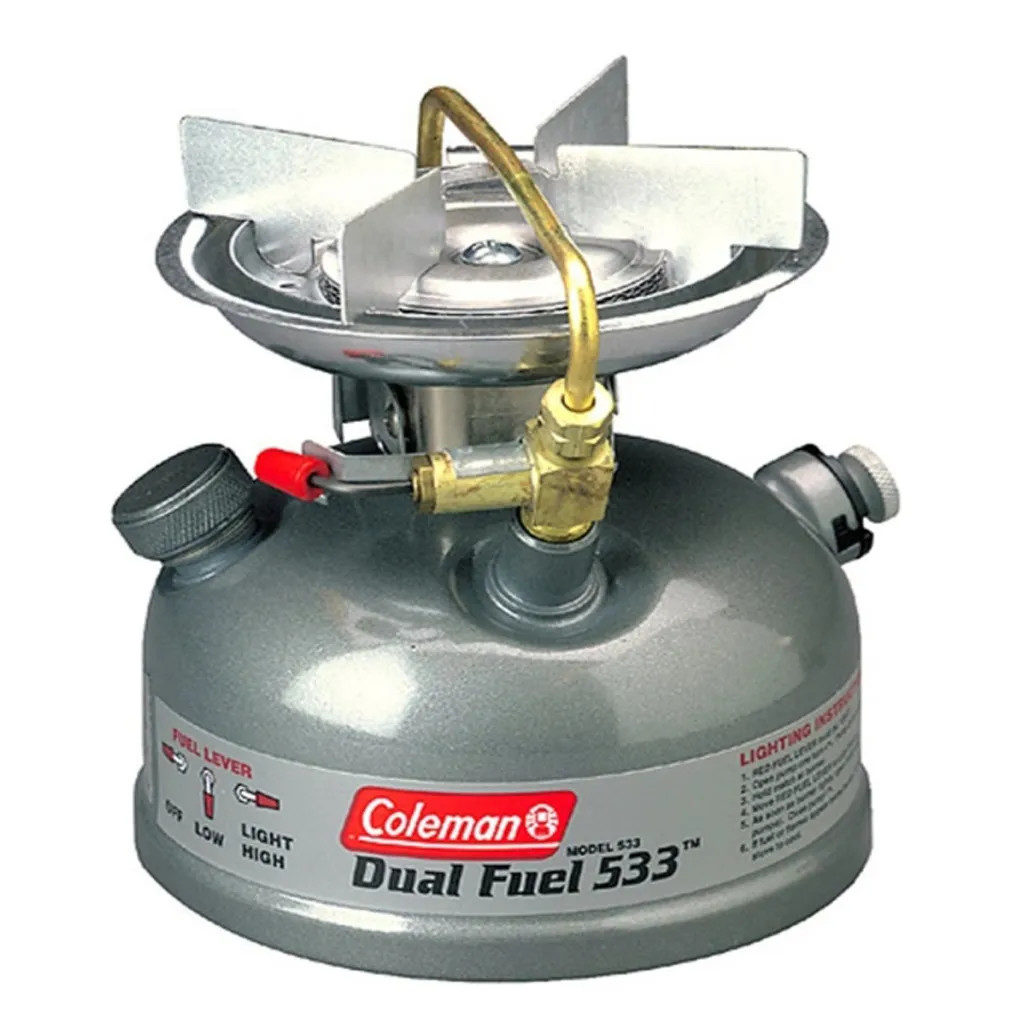
So Now What:
Eventually I’ll repair both my white gas devices. They’ll be scratched up but function like new. Both will have a personal history. They served me well when I was young, I used them happily when they were new. We were parted but reunite on the other side of life’s bell curve. Given basic maintenance and the continued accessibility of parts and white gas, they should last longer than I live.
I also have two brand new white gas / unleaded devices. If it’s only a temporary thing that they were hard to find they’ll re-appear on shelves. However, it is not a good era to wait for “normal” to return and I feel like I got them just as the sun set on their era. So many things that “always will be” have ended since 2019. The world is giving you the clue! I’m happy to have picked up the two devices just before their unofficial and little noted extinction. Maybe I’m wrong and they’re fully stocked at your local K-Mart.
Not a minor thought is that they’ll run off the same fuel that runs my motorcycle. There is almost nowhere on earth where you can’t get gasoline within a day’s travel. The new devices will probably outlast me too.
I’m pleased with how it’s coming together. I like owning two of everything. I like owning equipment that should outlast me. I like stuff that can be repaired. None of the four devices are plastic wonders that will fail when Microsoft ships its next update.
I’ll enjoy them this summer. Presumably, they’ll still be working when I’m dead. Future owners will either totally ignore them because they’re plugged into the Matrix, or use them heavily as they hunker in a far less advanced future. You’ve heard the joke: “What did socialists use for light before candles? Electricity!”
These are weird times. Don’t deny what your own eyes are telling you. If you want a physical object and it seems fleeting, heed the warning of the last few years. Get it now or be prepared to live without it forever.
A Nod To The Pedantics:
You’re dying to tell me Coleman isn’t the only liquid fuel / unleaded capable game in town. I found many variants of the MSR product line. They were in stock!
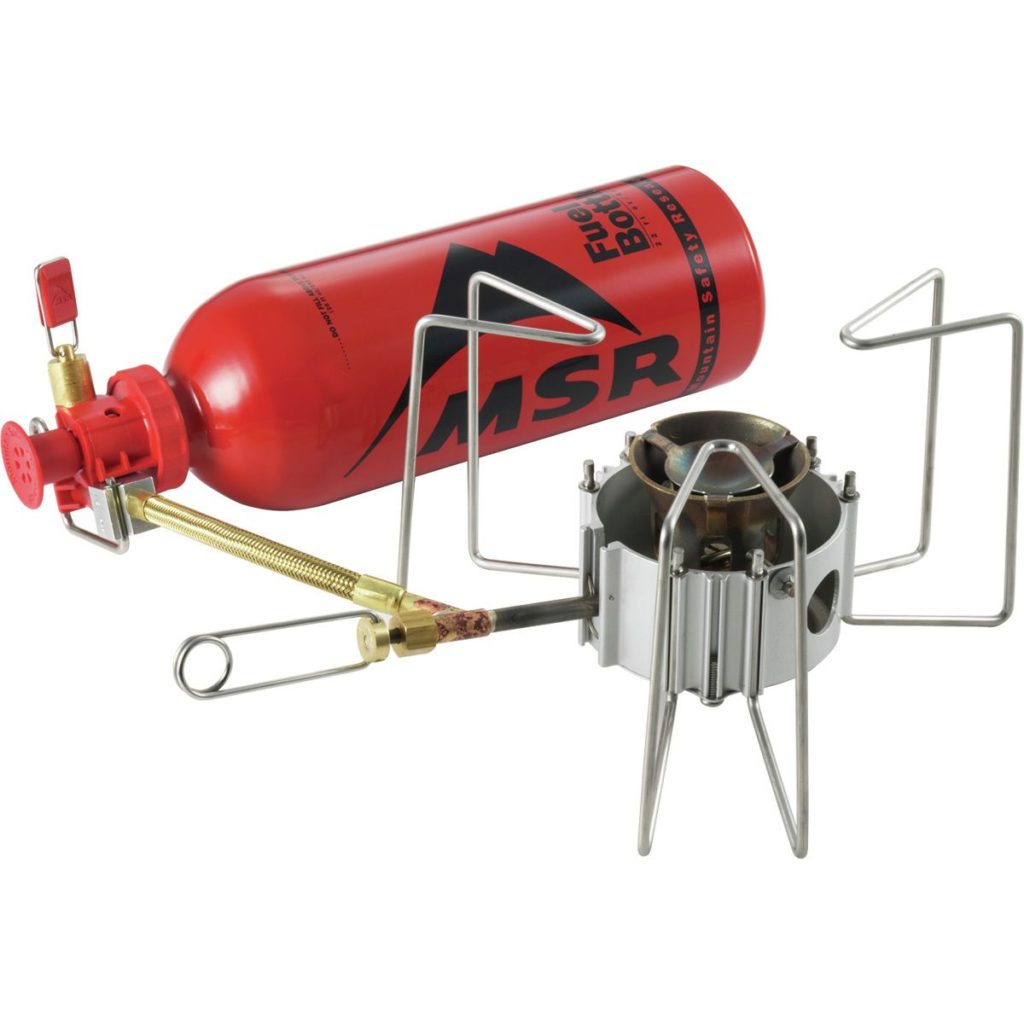
Nothing wrong with those. I just wanted the old Coleman style that’s tougher and cruder. The Coleman stove feels solid; like you can wallop a bear with it.
The MSR is functional but I irrationally I prefer the look of the Coleman. My new model 533 and my beloved old 400A are shaped like a lunar lander. They’re literally from the time when humanity could build and operate lunar landers and they feel like a reminder. Even if the MSR is awesome, it looks like a water bottle with a brake line.
You can’t stop the signal: you can buy an off brand knock-off of the Coleman 533 from the internet. I’ve never seen one in person but salute them for trying. Since Coleman abandoned the market, I hope they occupy the void and eat Coleman’s lunch. The only advantage of the Coleman is parts availability. It was only a little bit more to get the real deal and 40+ years of parts floating around can’t hurt.
One last pedantic note. I know that 1 pound propane tanks can be refilled. This changes their economics from ridiculously expensive to quasi-reasonable. Refiling LP tanks is either dangerous and banned or safe and legal depending on who you ask. I will not offer an opinion on this. (So many things in modern times are regulatory “grey areas”. That’s another hint about the evolving nature of what was once called rule of law.) Regardless, refilling an LP gas canister will never be as handy as pouring liquid into a tank and hand pumping.
Posted in Uncategorized
15 Comments
Seasonal Change At Curmudgeon Compound: Situation Report
The weather sucks and it’s screwing up my camping plans.
Seven months ago, I woke up in a tent and thought “this is good for me, I should do this more”. The decision was made, nature is good for the soul, therefore I would increase my camping time.
I have done less “more” than I’d like but more “more” than none. Life is the compromise between your intentions and your actions.
As the snow flew, I parked my dirt bike and spent an insane amount of money on a hot tent. Alas, there’s winter and there’s winter. This winter was not messing around. It was brutally cold for months at a time. (I spent my money replacing burst pipes instead of ice fishing!)
I set up my hot tent three times and spent a few nights “testing it” near my house. Where I live you don’t toy with winter until you know what you’re doing. It was less adventurous than I’d planned but I did ride out a genuine blizzard. In so doing I assured myself the tent is a fabric fortress. In my defense, the few brief “tests” were more winter camping than I’ve done in years.
Winter is not shifting easily into spring and at best it’s spring breakup; a time that’s neither winter nor truly spring. The forests are a wet muddy snow covered sponge and everything sucks. Remote travel was possible a month ago (if properly equipped) on frozen ice and it’ll be possible in a month-ish (when the land is dry). For now, like the log trucks, I’m temporarily grounded.
Note: In case you don’t know what the “log trucks are grounded” thing means, there’s a season in northern states where heavy trucks cannot legally (or practically) travel. This starts when the iced roads thaw and lasts through a soft muddy phase. Heavy vehicles can inadvertently tear the shit out of the soft vulnerable roads. Restrictions are lifted as the mud evolves back into dry roads. Even when travel is legal it’s impractical. Sometimes even small light vehicles are limited. Mud will mire a light jeep in the right conditions and a jeep can nuke a road quite handily if misused. Even foot travel sucks. Similar limits apply to ATV trails and (I think) horse trails; with a bunch of variation in practice and regulation. Lake ice still exists but it’s no longer sound. If you left your ice shack out there… it’s either already gone or will be soon.
To pass the time, I’m acquiring equipment for the summer. More on that in my next post. Stay tuned.
Posted in Uncategorized
2 Comments
Primus – Wynona’s Big Brown Beaver
Because nothing is more fun that creepy vinyl cowboy costumes!
Posted in Uncategorized
5 Comments
STEM
For a totally non-political laugh, I offer this documentary of my time in college. Enjoy:
Posted in Uncategorized
2 Comments
